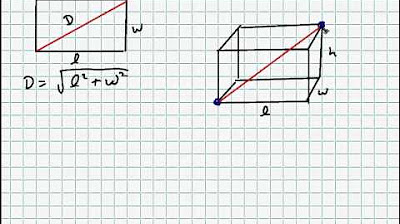How do we Derive the Pythagoras Theorem? Part 1 | Don't Memorise
Summary
TLDRIn this video, we explore the Pythagorean theorem using a visual approach. Starting with a right-angled triangle, we demonstrate how 'c' squared equals 'a' squared plus 'b' squared. The explanation uses a step-by-step method involving a square with side lengths 'a+b' and dividing it into smaller sections, including four right-angled triangles. The areas of these sections are calculated, leading to the conclusion that the sum of the areas equals the square of the hypotenuse. The video concludes by proving that 'c squared equals a squared plus b squared', effectively illustrating the Pythagorean theorem.
Takeaways
- 😀 The Pythagorean theorem relates the sides of a right-angled triangle, stating that c² = a² + b².
- 😀 To understand the Pythagorean theorem, we can visualize it through geometric construction, similar to squaring (a + b).
- 😀 Start by drawing a line of any length and marking a point on it. Divide it into two parts: 'a' and 'b'.
- 😀 The total length of the line is 'a' + 'b'.
- 😀 A square with side length (a + b) is constructed to explore the relationship further.
- 😀 The segments are divided into smaller sections where 'a' and 'b' alternate along the length of the line.
- 😀 After dividing the line, adjacent points are joined to form a square in the center with side 'c'.
- 😀 The outer square consists of five parts: the central square of side 'c' and four right-angled triangles with sides 'a' and 'b'.
- 😀 The area of the outer square can be calculated in two ways: by squaring (a + b) or summing the areas of the five parts.
- 😀 By equating the two area calculations, we derive the Pythagorean theorem: c² = a² + b², confirming the relationship between the sides of a right-angled triangle.
Q & A
What is the main concept behind the Pythagorean theorem as described in the script?
-The Pythagorean theorem states that for a right-angled triangle, the square of the hypotenuse (c) is equal to the sum of the squares of the other two sides (a and b), i.e., c² = a² + b².
How does the script demonstrate the Pythagorean theorem geometrically?
-The script uses a square with side length (a + b) and divides it into smaller sections, including four right-angled triangles and an inner square with side c. By calculating the area in two ways, it derives the formula c² = a² + b².
Why is the square with side length (a + b) used in the explanation?
-The square with side (a + b) serves as the outer structure to help visualize the areas of different parts, leading to a comparison between the areas of the outer square and the sum of its internal components.
What are the components inside the square, and how do they contribute to the solution?
-Inside the square, there is a smaller square with side c, along with four right-angled triangles, each with base b and height a. These components contribute to the area calculation, allowing the derivation of the Pythagorean theorem.
How is the area of the outer square calculated?
-The area of the outer square is calculated by squaring the side length (a + b), so the area is (a + b)².
How is the total area of the outer square expressed using the internal components?
-The total area of the outer square can also be expressed as the sum of the areas of the inner square (c²) and the four right-angled triangles (each with area 1/2 * a * b, so the total area of the four triangles is 2ab).
What is the relationship between the two expressions for the area of the outer square?
-Both expressions for the area of the outer square are equated: (a + b)² = c² + 2ab. By expanding (a + b)² and simplifying, we arrive at c² = a² + b².
How does the script use algebraic identities to derive the Pythagorean theorem?
-The script expands (a + b)² to a² + 2ab + b², then equates this to c² + 2ab. After canceling out the 2ab terms, the result is c² = a² + b².
What role do the right-angled triangles play in the geometric explanation?
-The right-angled triangles help demonstrate how their areas, when combined, contribute to the total area of the outer square. Their areas are directly linked to the sides a and b, which leads to the final formula.
Why is it important to cancel out the 2ab term in the equation?
-Canceling out the 2ab term simplifies the equation and isolates c², allowing for the final conclusion that c² equals a² + b², which is the essence of the Pythagorean theorem.
Outlines

Esta sección está disponible solo para usuarios con suscripción. Por favor, mejora tu plan para acceder a esta parte.
Mejorar ahoraMindmap

Esta sección está disponible solo para usuarios con suscripción. Por favor, mejora tu plan para acceder a esta parte.
Mejorar ahoraKeywords

Esta sección está disponible solo para usuarios con suscripción. Por favor, mejora tu plan para acceder a esta parte.
Mejorar ahoraHighlights

Esta sección está disponible solo para usuarios con suscripción. Por favor, mejora tu plan para acceder a esta parte.
Mejorar ahoraTranscripts

Esta sección está disponible solo para usuarios con suscripción. Por favor, mejora tu plan para acceder a esta parte.
Mejorar ahoraVer Más Videos Relacionados
5.0 / 5 (0 votes)






